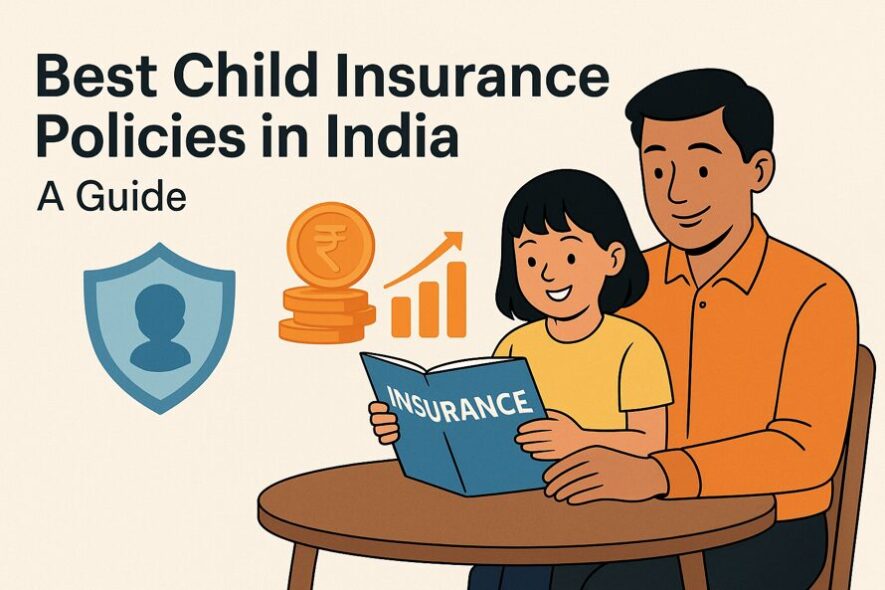
Introduction to Child Insurance in India
Every parent dreams of giving their child the best life possible, quality education, a safe home, and the right opportunities to succeed. But life doesn’t always play fair. Jobs shift, markets tumble, health crises strike, and sometimes, the person who provides the income may no longer be around. That’s where a child insurance plan becomes more than just another financial product; it becomes a promise.
In India, child insurance has gained traction because families recognize that rising costs won’t wait. College admissions, study-abroad programs, or even skill-based training courses often require substantial financial investments. A well-chosen child policy builds a protective wall around these goals. It combines life cover with disciplined savings or investments, ensuring that even if something unexpected happens, the child’s dreams don’t collapse.
Unlike plain term insurance, child insurance plans are built around milestones. They’re designed to release funds when the child needs them most, say at 18 for undergraduate studies, 21 for higher education, or later for setting up a business. This makes them practical, relevant, and deeply reassuring for Indian families.
Why You Need a Child Insurance Policy
Education inflation is real. An MBA at a reputed institute that cost ₹10 lakh a decade ago would cost ₹30 lakh today. Add in foreign education, where tuition and living expenses rise every year, and the figure crosses ₹50–60 lakh easily. Without a structured plan, such expenses can crush household finances.
A child insurance policy tackles this challenge head-on. It gives a mix of security and growth. The life cover ensures that if something happens to the parent, the child is financially protected. The savings or investment portion grows steadily, creating a ready pool of money for future milestones.
There’s also discipline built in. Unlike random investments that get paused or withdrawn midway, insurance-linked plans bind you to a schedule. You pay premiums regularly, which automatically keeps you on track to build the corpus. Over 10–20 years, that consistency makes a world of difference.
For many Indian households, another big reason is peace of mind. Parents don’t want uncertainty hanging over their child’s future. A child plan removes that worry, letting them focus on nurturing talents and values while the money part is secured.
Types of Child Insurance Plans
Child Endowment Plans
These are classic, low-risk insurance products. Parents pay premiums, mostly invested in debt instruments. At maturity, the child receives a lump sum plus a bonus. Endowment plans suit families who prefer predictability over market-linked volatility.
Consider LIC’s New Children’s Money Back Plan as an example. It pays survival benefits at fixed ages, 18, 20, and 22, and then a maturity benefit at 25. This staggered structure mirrors education milestones. Parents who don’t want to gamble on markets often find this format comfortable.
Child ULIPs (Unit Linked Insurance Plans)
ULIPs offer a blend of insurance and market-linked investments. A part of your premium goes into life cover, while the rest is invested in equity or debt funds. Over time, this creates a growth-oriented corpus.
The attraction lies in flexibility. Parents can switch between equity and debt based on market conditions. Plans like ICICI Pru SmartKid Premier and Max Life Shiksha Plus Super give this option. Over a 15–20 year horizon, ULIPs have the potential to create wealth that keeps pace with education inflation.
Term Plans with Child Benefits
Think of these as extended term life covers with add-ons for children. If the insured parent dies during the policy term, the insurer pays a lump sum, waives all future premiums, and continues the policy benefits for the child.
For example, the ICICI Pru SmartKid Guarantee Plan ensures that even if the parent is no longer alive, the policy doesn’t lapse. The child still receives payouts as planned. This feature offers unmatched reassurance to families.
Education Plans
Education plans are milestone-driven. They release funds at specific stages of the child’s education. A good example is HDFC Life YoungStar Udaan, which has options like Academia and Career. It aligns payouts with the last 5 years of policy term, matching college admission timelines. Parents love the direct link between policy payouts and real-world education costs.
Top Child Insurance Policies in India (2025 Edition)
Here are some of the most reliable child insurance plans available right now:
- HDFC Life YoungStar Udaan: Participating endowment plan with guaranteed additions, bonuses, and milestone-linked payouts. Designed specifically for higher education costs.
- ICICI Pru SmartKid Guarantee Plan: Offers guaranteed lump sum benefits with Waiver of Premium. Income options range from 5 to 30 years.
- ICICI Pru SmartKid Premier ULIP: A flexible ULIP with equity and debt funds, loyalty additions, and partial withdrawals. Good for parents seeking market exposure.
- SBI Life Smart Champ Insurance: Focuses on four key education stages. Offers a lump sum on death plus a waiver of premium to keep the plan active.
- LIC New Children’s Money Back Plan: A traditional choice with fixed survival benefits at ages 18, 20, and 22, plus maturity at 25.
- Max Life Shiksha Plus Super: ULIP-based plan with market-linked growth, multiple fund choices, and loyalty additions.
Key Features to Compare in Child Insurance Policies
Premium Payment Options
Policies offer flexibility. Some let you pay for just 7–10 years but keep the coverage active for 20 years or more. Others demand regular payment throughout. For example, SBI Life Smart Champ allows limited pay terms, making it easier for parents with fluctuating incomes.
Maturity Benefits
Endowment and money-back policies guarantee maturity benefits. ULIPs vary with fund performance. Education plans align payouts with specific ages. Always match the payout structure with your child’s expected education stages.
Waiver of Premium
This is non-negotiable. If the premium payer passes away, the insurer waives future premiums, and the child still receives the planned benefits. Both HDFC YoungStar Udaan and ICICI SmartKid include this crucial feature.
Policy Term and Payout Options
Most plans last 15–25 years. Parents should align the term so that payouts match higher education years. If your child is 5 today, a 15-year plan maturing when they’re 20 is ideal. Payouts can be lump sum or staggered.
Riders and Add-Ons
Add-ons like critical illness riders, accidental death riders, or income benefit riders add another layer of security. For a small extra cost, they ensure the plan stays solid even when life throws challenges.
How to Choose the Right Child Insurance Policy
Assessing Future Education Costs
Start with actual numbers. If you expect your child to pursue an MBA in 15 years, estimate the cost with 8–10% inflation. A ₹20 lakh course today may need ₹40–45 lakh then. Choose a policy sum assured that covers this.
Evaluating Investment vs. Insurance Needs
Risk-averse parents may pick endowment or education plans. Risk-takers might prefer ULIPs for higher growth. Always match the policy type with your comfort level in handling market swings.
Comparing Plans and Insurers
Look beyond brand names. Compare claim settlement ratios, maturity benefits, bonus histories, and fund performance. LIC gives legacy trust, while private players like HDFC and ICICI provide flexible, market-linked options.
Reading Policy Documents Carefully
Check premium allocation charges in ULIPs, guaranteed additions in endowment plans, and terms for bonus accrual. Don’t skip the fine print; it decides how much your child actually gets.
Tax Benefits of Child Insurance Plans in India
Premiums qualify for deductions under Section 80C up to ₹1.5 lakh per year. Maturity proceeds are exempt under Section 10 (10D) if conditions are met. ULIP fund switches are tax-free. This dual benefit of protection plus tax savings makes child plans attractive for salaried families.
Common Mistakes to Avoid When Buying Child Insurance
- Starting too late: Premiums are cheaper and compounding is stronger when you begin early.
- Underestimating education inflation: A policy with a ₹10 lakh maturity won’t cover a ₹30 lakh course later.
- Ignoring waiver of premium: Without this, the policy ends if the parent dies.
- Skipping comparison: Don’t settle for the first plan. Explore at least three.
- Choosing the wrong term: If maturity arrives before college starts, funds sit idle. Too late, and you scramble for fees.
Conclusion
Child insurance is a strategy for peace of mind. It ensures that education dreams, health needs, and career goals stay intact, even if life takes an unpredictable turn. Plans like HDFC Life YoungStar Udaan, ICICI Pru SmartKid, SBI Smart Champ, and LIC’s Money Back Plan serve different needs.
The smartest move is to start early, calculate realistically, and pick a plan that balances safety with growth. With rising costs and uncertain times, having a child insurance plan is not just wise, it’s essential. It keeps your child’s future secure, no matter what tomorrow brings.
FAQs:
Which is the best child insurance policy in India right now?
There isn’t a single “best” plan, but popular options in 2025 include HDFC Life YoungStar Udaan, ICICI Pru SmartKid Guarantee Plan, and SBI Life Smart Champ Insurance. The right pick depends on your goal—guaranteed payouts, market-linked growth, or milestone-based education funding.
What is the ideal age to start a child insurance plan?
The sooner, the better. Most experts suggest starting when your child is between 0–5 years old. This gives you a longer horizon for compounding and lower premiums.
Can both parents be covered under a child insurance plan?
Yes. Some insurers allow joint life options where both parents are covered. If one passes away, the policy continues with a waiver of premium, and the child still receives the benefits as planned.
Are child insurance plans tax-deductible under 80C?
Absolutely. Premiums paid toward child insurance qualify for a deduction under Section 80C (up to ₹1.5 lakh per year). Maturity payouts can also be tax-free under Section 10 (10D) if conditions are met.
What happens if the parent dies during the policy term?
The insurer pays a lump sum immediately, waives future premiums, and continues the policy benefits. This ensures the child still receives education or milestone payouts as scheduled, without any disruption.
How do child ULIPs differ from traditional plans?
Child ULIPs invest part of the premium in market-linked funds like equity or debt, offering higher growth potential with some risk. Traditional plans, like endowment or money-back, stick to guaranteed returns, giving safety but lower growth.
Is a child’s education plan better than a savings plan?
Yes, for long-term goals. A child’s education plan is designed with milestone-based payouts and life cover, ensuring funds are available when needed. A plain savings plan lacks that protection and structured benefit.




